Ezgi Ozyilkan
Neural Compress-and-Forward for the Relay Channel
Apr 22, 2024



Abstract:The relay channel, consisting of a source-destination pair and a relay, is a fundamental component of cooperative communications. While the capacity of a general relay channel remains unknown, various relaying strategies, including compress-and-forward (CF), have been proposed. For CF, given the correlated signals at the relay and destination, distributed compression techniques, such as Wyner-Ziv coding, can be harnessed to utilize the relay-to-destination link more efficiently. In light of the recent advancements in neural network-based distributed compression, we revisit the relay channel problem, where we integrate a learned one-shot Wyner--Ziv compressor into a primitive relay channel with a finite-capacity and orthogonal (or out-of-band) relay-to-destination link. The resulting neural CF scheme demonstrates that our task-oriented compressor recovers "binning" of the quantized indices at the relay, mimicking the optimal asymptotic CF strategy, although no structure exploiting the knowledge of source statistics was imposed into the design. We show that the proposed neural CF scheme, employing finite order modulation, operates closely to the capacity of a primitive relay channel that assumes a Gaussian codebook. Our learned compressor provides the first proof-of-concept work toward a practical neural CF relaying scheme.
Robust Distributed Compression with Learned Heegard-Berger Scheme
Mar 13, 2024



Abstract:We consider lossy compression of an information source when decoder-only side information may be absent. This setup, also referred to as the Heegard-Berger or Kaspi problem, is a special case of robust distributed source coding. Building upon previous works on neural network-based distributed compressors developed for the decoder-only side information (Wyner-Ziv) case, we propose learning-based schemes that are amenable to the availability of side information. We find that our learned compressors mimic the achievability part of the Heegard-Berger theorem and yield interpretable results operating close to information-theoretic bounds. Depending on the availability of the side information, our neural compressors recover characteristics of the point-to-point (i.e., with no side information) and the Wyner-Ziv coding strategies that include binning in the source space, although no structure exploiting knowledge of the source and side information was imposed into the design.
Distributed Compression in the Era of Machine Learning: A Review of Recent Advances
Feb 12, 2024

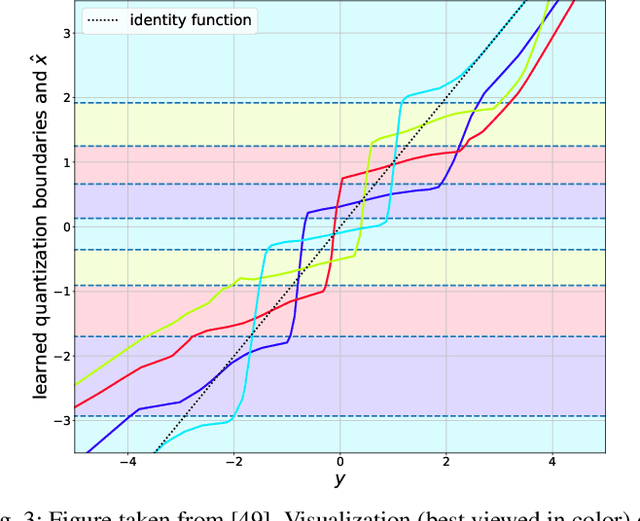
Abstract:Many applications from camera arrays to sensor networks require efficient compression and processing of correlated data, which in general is collected in a distributed fashion. While information-theoretic foundations of distributed compression are well investigated, the impact of theory in practice-oriented applications to this day has been somewhat limited. As the field of data compression is undergoing a transformation with the emergence of learning-based techniques, machine learning is becoming an important tool to reap the long-promised benefits of distributed compression. In this paper, we review the recent contributions in the broad area of learned distributed compression techniques for abstract sources and images. In particular, we discuss approaches that provide interpretable results operating close to information-theoretic bounds. We also highlight unresolved research challenges, aiming to inspire fresh interest and advancements in the field of learned distributed compression.
Neural Distributed Compressor Discovers Binning
Oct 25, 2023
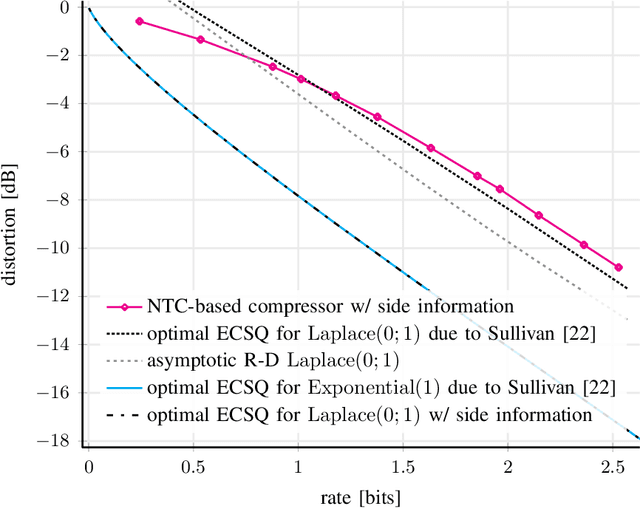

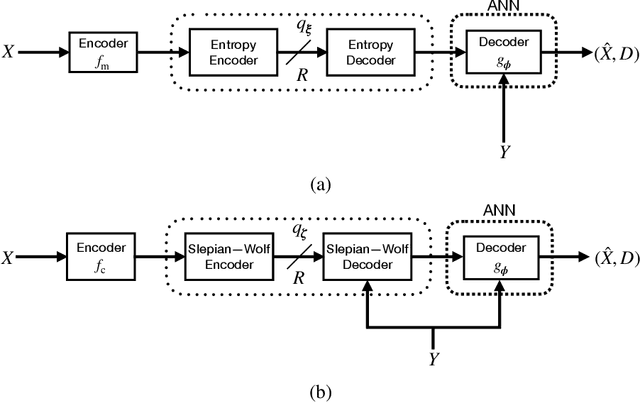
Abstract:We consider lossy compression of an information source when the decoder has lossless access to a correlated one. This setup, also known as the Wyner-Ziv problem, is a special case of distributed source coding. To this day, practical approaches for the Wyner-Ziv problem have neither been fully developed nor heavily investigated. We propose a data-driven method based on machine learning that leverages the universal function approximation capability of artificial neural networks. We find that our neural network-based compression scheme, based on variational vector quantization, recovers some principles of the optimum theoretical solution of the Wyner-Ziv setup, such as binning in the source space as well as optimal combination of the quantization index and side information, for exemplary sources. These behaviors emerge although no structure exploiting knowledge of the source distributions was imposed. Binning is a widely used tool in information theoretic proofs and methods, and to our knowledge, this is the first time it has been explicitly observed to emerge from data-driven learning.
Distributed Deep Joint Source-Channel Coding with Decoder-Only Side Information
Oct 06, 2023Abstract:We consider low-latency image transmission over a noisy wireless channel when correlated side information is present only at the receiver side (the Wyner-Ziv scenario). In particular, we are interested in developing practical schemes using a data-driven joint source-channel coding (JSCC) approach, which has been previously shown to outperform conventional separation-based approaches in the practical finite blocklength regimes, and to provide graceful degradation with channel quality. We propose a novel neural network architecture that incorporates the decoder-only side information at multiple stages at the receiver side. Our results demonstrate that the proposed method succeeds in integrating the side information, yielding improved performance at all channel noise levels in terms of the various distortion criteria considered here, especially at low channel signal-to-noise ratios (SNRs) and small bandwidth ratios (BRs). We also provide the source code of the proposed method to enable further research and reproducibility of the results.
Learned Wyner-Ziv Compressors Recover Binning
May 07, 2023


Abstract:We consider lossy compression of an information source when the decoder has lossless access to a correlated one. This setup, also known as the Wyner-Ziv problem, is a special case of distributed source coding. To this day, real-world applications of this problem have neither been fully developed nor heavily investigated. We propose a data-driven method based on machine learning that leverages the universal function approximation capability of artificial neural networks. We find that our neural network-based compression scheme re-discovers some principles of the optimum theoretical solution of the Wyner-Ziv setup, such as binning in the source space as well as linear decoder behavior within each quantization index, for the quadratic-Gaussian case. These behaviors emerge although no structure exploiting knowledge of the source distributions was imposed. Binning is a widely used tool in information theoretic proofs and methods, and to our knowledge, this is the first time it has been explicitly observed to emerge from data-driven learning.
Learned Disentangled Latent Representations for Scalable Image Coding for Humans and Machines
Jan 10, 2023



Abstract:As an increasing amount of image and video content will be analyzed by machines, there is demand for a new codec paradigm that is capable of compressing visual input primarily for the purpose of computer vision inference, while secondarily supporting input reconstruction. In this work, we propose a learned compression architecture that can be used to build such a codec. We introduce a novel variational formulation that explicitly takes feature data relevant to the desired inference task as input at the encoder side. As such, our learned scalable image codec encodes and transmits two disentangled latent representations for object detection and input reconstruction. We note that compared to relevant benchmarks, our proposed scheme yields a more compact latent representation that is specialized for the inference task. Our experiments show that our proposed system achieves a bit rate savings of 40.6% on the primary object detection task compared to the current state-of-the-art, albeit with some degradation in performance for the secondary input reconstruction task.
Neural Distributed Image Compression with Cross-Attention Feature Alignment
Jul 18, 2022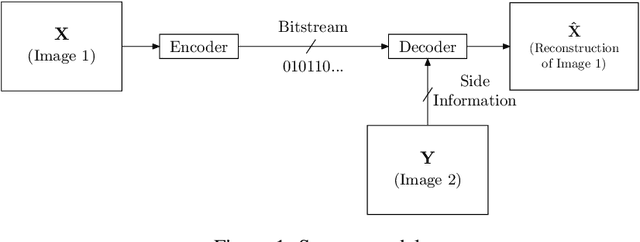
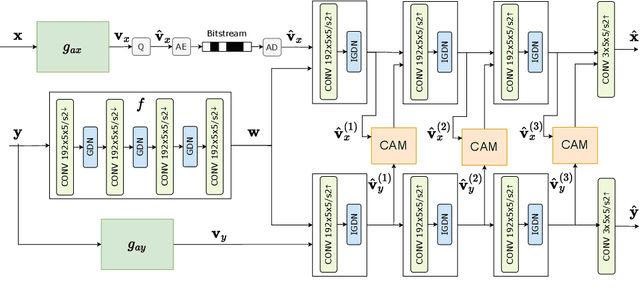
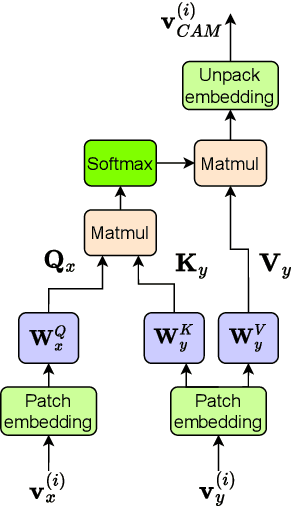
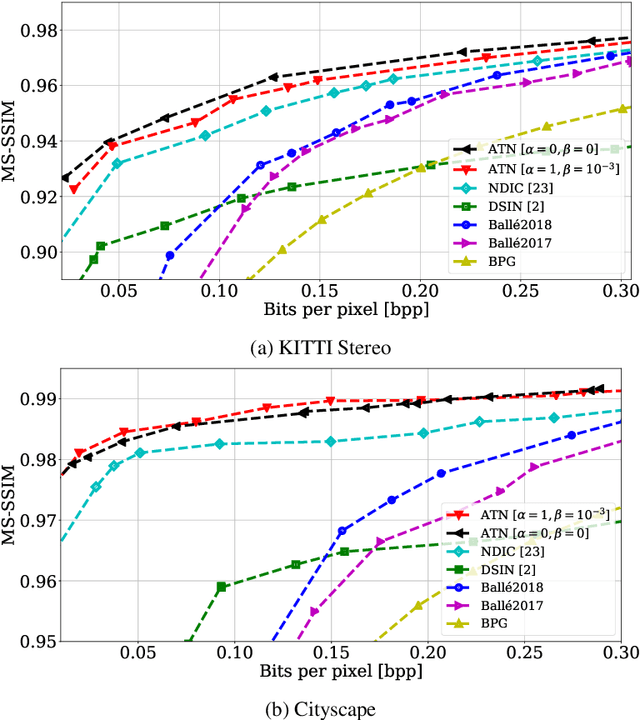
Abstract:We propose a novel deep neural network (DNN) architecture for compressing an image when a correlated image is available as side information only at the decoder side, a special case of the well-known and heavily studied distributed source coding (DSC) problem. In particular, we consider a pair of stereo images, which have overlapping fields of view, captured by a synchronized and calibrated pair of cameras; and therefore, are highly correlated. We assume that one image of the pair is to be compressed and transmitted, while the other image is available only at the decoder. In the proposed architecture, the encoder maps the input image to a latent space using a DNN, quantizes the latent representation, and compresses it losslessly using entropy coding. The proposed decoder extracts useful information common between the images solely from the available side information, as well as a latent representation of the side information. Then, the latent representations of the two images, one received from the encoder, the other extracted locally, along with the locally generated common information, are fed to the respective decoders of the two images. We employ a cross-attention module (CAM) to align the feature maps obtained in the intermediate layers of the respective decoders of the two images, thus allowing better utilization of the side information. We train and demonstrate the effectiveness of the proposed algorithm on various realistic setups, such as KITTI and Cityscape datasets of stereo image pairs. Our results show that the proposed architecture is capable of exploiting the decoder-only side information in a more efficient manner as it outperforms previous works. We also show that the proposed method is able to provide significant gains even in the case of uncalibrated and unsynchronized camera array use cases.
Deep Stereo Image Compression with Decoder Side Information using Wyner Common Information
Jun 22, 2021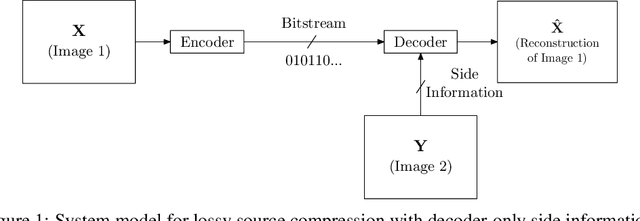
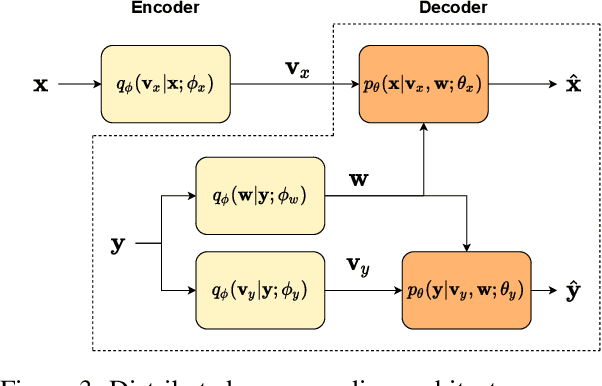
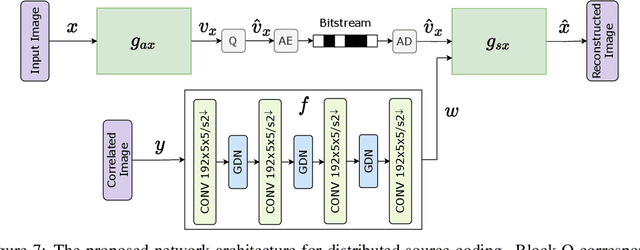
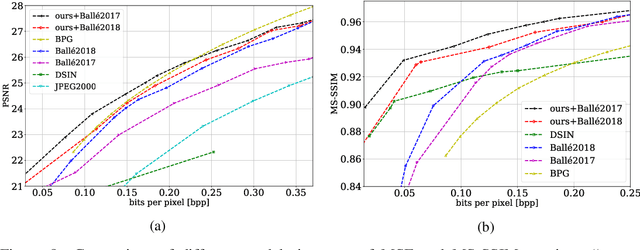
Abstract:We present a novel deep neural network (DNN) architecture for compressing an image when a correlated image is available as side information only at the decoder. This problem is known as distributed source coding (DSC) in information theory. In particular, we consider a pair of stereo images, which generally have high correlation with each other due to overlapping fields of view, and assume that one image of the pair is to be compressed and transmitted, while the other image is available only at the decoder. In the proposed architecture, the encoder maps the input image to a latent space, quantizes the latent representation, and compresses it using entropy coding. The decoder is trained to extract the Wyner's common information between the input image and the correlated image from the latter. The received latent representation and the locally generated common information are passed through a decoder network to obtain an enhanced reconstruction of the input image. The common information provides a succinct representation of the relevant information at the receiver. We train and demonstrate the effectiveness of the proposed approach on the KITTI dataset of stereo image pairs. Our results show that the proposed architecture is capable of exploiting the decoder-only side information, and outperforms previous work on stereo image compression with decoder side information.
Deep Joint Transmission-Recognition for Multi-View Cameras
Nov 03, 2020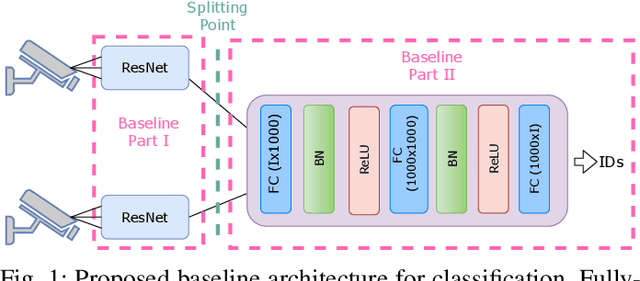

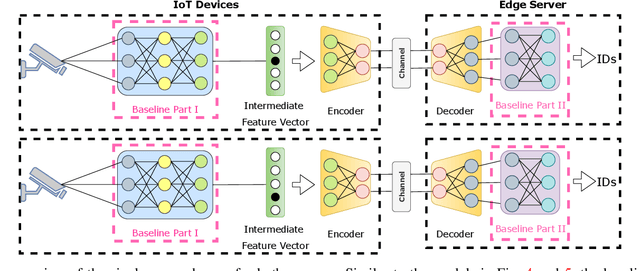
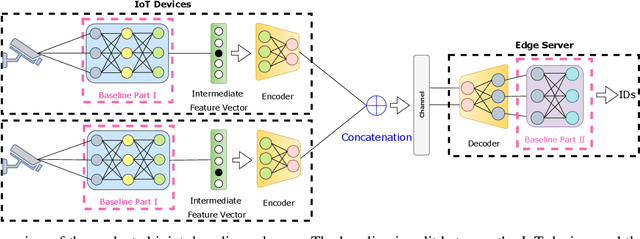
Abstract:We propose joint transmission-recognition schemes for efficient inference at the wireless edge. Motivated by the surveillance applications with wireless cameras, we consider the person classification task over a wireless channel carried out by multi-view cameras operating as edge devices. We introduce deep neural network (DNN) based compression schemes which incorporate digital (separate) transmission and joint source-channel coding (JSCC) methods. We evaluate the proposed device-edge communication schemes under different channel SNRs, bandwidth and power constraints. We show that the JSCC schemes not only improve the end-to-end accuracy but also simplify the encoding process and provide graceful degradation with channel quality.
 Add to Chrome
Add to Chrome Add to Firefox
Add to Firefox Add to Edge
Add to Edge